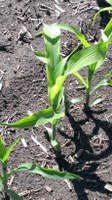Watch for Sulfur Deficiency in Corn
(Click the image below to view a high-resolution image that can be downloaded)
Sulfur deficiency could be a big problem in corn this year, North Dakota State University Extension Service soil science specialist Dave Franzen warns.
“Sulfur (S) deficiency in corn is as widespread as I have ever seen it,” he says. “I applied 20 pounds of S as gypsum preplant to all my corn plots in the southeastern part of the state this year and several, particularly in loams/sandy loams, look like green islands in a yellow sea of corn.
“In the very southeastern part of the state where rainfall in loams to clay loams has been higher than most areas, even my plot area is showing symptoms, and my crew applied ammonium sulfate to my potassium rate trials yesterday just to make sure it was OK,” he adds
Producers should look for yellow, subtly striped upper/new leaves, with greener leaves beneath. If producers see green/yellow variability in the field, they should compare a plant sample from the green area with a plant from the yellow area to complete their diagnosis.
University researchers also should take note of any sulfur deficiency because it will affect the results of their trials, Franzen says.
He stresses that soil tests for sulfur are useless, so producers and researchers should not base their diagnosis on such tests.
The simplest solution to correct sulfur deficiency might be to apply ammonium sulfate dry over the top of the corn at a rate of 50 pounds per acre, according to Franzen. Three gallons per acre of ammonium thiosulfate streamed between the rows also would work, but it should not be broadcast.
“Supplements are needed as soon as possible,” he says. “Plots I let go until the V8 corn growth stage never recovered fully last year because the soil dried up soon afterward, and they never got a chance to root down early enough in the season. Maybe midseason will be wetter this year, but you never know, so earlier is better when applying supplements.”
Visit http://tinyurl.com/soilfertility for more soil fertility recommendations for corn.
NDSU Agriculture Communication - June 15, 2015
| Source: | Dave Franzen, (701) 231-8656, david.franzen@ndsu.edu |
|---|---|
| Editor: | Ellen Crawford, (701) 231-5391, ellen.crawford@ndsu.edu |


